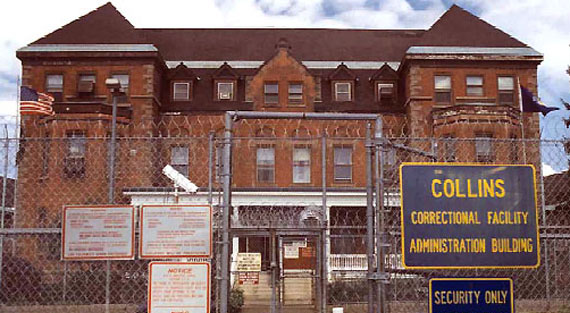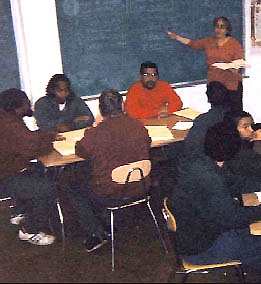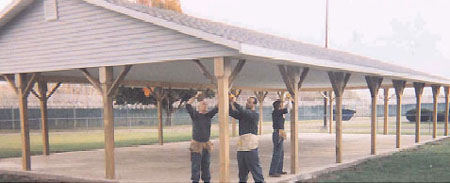CollinsSituated on the grounds of the former Gowanda Psychiatric Center, which opened in 1898, Collins is located in an area of New York that is rich with long-time and diverse historical roots. This is an area where, many years ago, Indians roamed the terrain, as did Quakers looking to make a better life for themselves and others. But despite its pristine beginnings, it has its dark side; many are convinced spirits, former residents of the psychiatric center, are about. It is that kind of intriguing lore that continually drives Collins employees and other local residents to learn more about the place they call home. Indeed, the history of the region is something in which employees and many local residents take great pride.They can be seen spending hours in area libraries and other places throughout the community poring over old books, ledgers, maps and other historical documents to get a glimpse of what life was like in this western part of the Empire State many generations ago. This area of the town of Collins has been occupied since 1660 by the Seneca Indians, who succeeded the Kahquah and Erie tribes in western New York. By terms of the Canandaigua Treaty of 1794, the Senecas settled on reservations, including the Cattaraugus Reservation. In 1808, the Society of Friends (Quakers) purchased 700 acres of land next to the Cattaraugus Reservation for settlement by people who came to the region with the sole purpose of helping the Indians. That same year the noted Quaker missionary, Jacob Taylor, arrived in the area by means of an old Indian trail. He built a home near the reservation in an area that became known as Taylor Hollow. By 1810, 14 other families had joined him in Taylor Hollow and by 1821, with 92 families now living there, the area was officially organized as Collins. (What is now known as North Collins officially separated from Collins in 1852). Settlers were continually attracted to Collins by the selfless motive of aiding the Indians; the fact that there were a lot of agricultural opportunities in the region also served as a big draw. Before farms could be established in the area, however, the landscape had to be cleared of very thickwoods. Literally thousands of trees were cut and burned by the local residents. The resulting impressive mounds of tree ash were then sold to be converted to pearl ash for use in 19th century industry. The picturesque creeks that flow through the Collins area also provided the early settlers with power for gristmills. The creeks also powered the sawmills that were built by the early settlers to produce the lumber that would be needed to build the houses, barns, furniture, prisons and planks used for roads to accommodate the needs of a growing population (Versailles Plank Road, which runs through the Cattaraugus Reservation, was, itself, once a plank road). From its long-ago and humble beginnings, Collins also has had tanners who have made leather goods such as shoes and harnesses. And not surprisingly, years ago there were also a bevy of blacksmiths who made and repaired the tools and wagons that were so vital to the survival of the local residents. From early times right up to the present, people in the Collins area have engaged in fruit, vegetable and dairy farming, successful ventures due to the rich nature of the soil in the region. Itís also interesting to note that members of Jacob Taylorís family maintained a herd of Holstein cattle that in a bygone era roamed the grounds of what now is Collins and the adjacent Gowanda Correctional Facility. Additionally, production of maple syrup and sugar was started by the early settlers, productive and profitable ventures that continue today in the region, even at Collins. The first school was established in Collins in 1811 to teach reading, spelling, writing and arithmetic to children. Five schools functioned by 1815 in the Collins area, an indicator of the continued pilgrimage of residents to the region. Over the years there were more schools developed with an expanding curricula typical of the modern schools of today.A Collins Center training building constructed in 1925 originally served as a school, replacing a school constructed in the early 1880s.
New York state set its sights on building a sprawling psychiatric center in the early 1890s and its gaze turned west toward Collins. After some preliminary discussions and negotiations, the state in 1894 took title to the 500-acre Taylor Farm that had been developed on land that Jacob Taylor had bequeathed to his many nieces and nephews. The first building of the Gowanda Osteopathic Hospital was completed in 1898; it is still in use today, with Collins using it to house administrative offices, inmate housing units, various programming areas and an infirmary. Over the years, nearly 100 more buildings were built on the site, many of which are still in use today. They were needed to care for the burgeoning patient population. In its heyday, the Gowanda Psychiatric Center cared for over 4,000 patients at a time. For almost a century, the Gowanda Psychiatric Center had a relatively uneventful existence. Society, however, was changing. In the late 1970s and early 1980s, it entered an era when new psychotropic medicines were being developed. At the same time, more and more psychiatric patients were being moved to community-based treatment residences. The once-bustling psychiatric centers of years ago were downsizing at a rapid rate; conversely, DOCS was in need of bed space. The crack epidemic that was gripping not only New York state but the entire nation prompted the need for more new beds to handle an increasing inmate population, and the Department needed the beds quickly. In 1982, the state took over 40 percent of the Gowanda Psychiatric Hospital and began the gradual conversion of the psychiatric center into a medium-security prison. It wasnít too long after that that the first inmates arrived. An anecdote that long has circulated about the opening of Collins involves temporary staff housing for the facilityís employees. The staff housing was in a dorm-style setting in the old morgue of the psychiatric center. Many employees did not want to sleep there because there were daunting tales of ghosts haunting the area. The building today is used for the storage of records. Because many of the old buildings that once housed psychiatric patients are still is use today, Collins is somewhat of a hodgepodge, and an unusual one at that. Collins has the capacity to house 1,280 inmates in a combination of dormitories, multiple-occupancy rooms, single cells and double cells. Itís also divided into two separate compounds, each with their own secured perimeter fencing, known as Collins I and Collins II. Each compound has its own mess hall, law library, visiting room and processing area, chapel, health services unit, commissary area, counseling units and recreation areas. Collins features a 110-bed Protective Custody Unit (PCU) which opened in 1995. The PCU segregates those inmates who might be vulnerable in general population in a secured environment away from that population while still providing them with access to various services. These inmates are afforded education, Alcohol and Substance Abuse Treatment (ASAT), volunteer service programming and counseling and most of all, a safe and secure environment to serve their sentences. Prior to the opening eight years ago of the Collins PCU, there was only one medium-security PCU in the state, a 22-bed unit at Oneida.
Collins also is the site of one of the stateís nine maximum security S-Blocks. These 100-cell, double-occupancy units are designed to segregate from the general population those inmates who chose to assault staff and others and disobey prison rules. These units are partially responsible for fewer assaults at Collins and at other prisons throughout New York state. Collins also offers a Family Reunion Program. This program affords approved inmates and their families the opportunity to meet overnight for a 44-hour period in a private home-like setting. The families spend time together in one of four units that were constructed by vocational inmates and Maintenance Department staff. The goal of the program is to preserve and strengthen family ties. . . . The program contributes to safer prisons, as participating inmates are less likely to misbehave and run the risk of not being able to spend time with their families. Collins also features a Visitors Hospitality Center staffed during weekend visiting by local volunteers. The majority of the visitors to Collins and Gowanda, also serviced at the hospitality center, take long bus rides from New York City to visit their loved ones. The center gives them a chance to freshen up and take care of other needs before entering the prison visiting room. Another unusual program offered at Collins is the production of maple syrup. The process typically begins each year in early February and runs with the sap until the beginning of April. The procedure begins when the sap is collected using milk bags . . . . The production of maple syrup is a favorite chore among many of the inmates assigned to the lawns and grounds crew. This is especially true of the inmates who come from cities . . . The syrup then is served to the inmate population during the breakfast mess hall meals atop pancakes or waffles. The old buildings and the varied distinct inmate populations arenít the only things that separate Collins from other prisons throughout the state, albeit outside the secured perimeters. . . . For instance, there are four separate cemeteries that date back to the beginning of the 20th century.More than 1,800 men and women, patients of the psychiatric center, were interred in state ground between 1898 and 1991. Also located outside the fences is the Helmuth Daycare Center, in operation since the mid-1960s. The center is open to all members of the community. State Office of Mental Health (OMH) officials still have a presence on the grounds, providing residential and outpatient psychiatric services to many of its clients in western NewYork. One of the services is a patient-run car wash. And finally, the Gowanda Area Federal Credit Union also is located on the grounds. . . . In addition to its 12 vocational shops and standard academic classes, Collins offers the Departmentís successful ASAT program as well as the Aggression Replacement Training (ART) to inmates when they first enter the facility. . . . . . . Collins has seen the number of inmate-oninmate assaults decline 78 percent between 1996 and 2001, from 41 to nine. The facility also had a 64 percent decline in the number of unusual incidents since 1996, down from 159 to 57, and inmate-on-staff assaults had fallen 83 percent, from 12 in 1996 to just two in 2001. No inmate escapes from the secured perimeter of the facility have occurred since it opened. . . . From the beginning, Collins has been distinguished by its commitment to therapeutic counseling groups providing sex offender counseling for 18 years. It also offers other groups addressing effective parenting, violence, gambling, criminal thinking and, for several years, amajor work release ASAT Relapse program.
Until August of 2000 Collins also offered a limited number of college courses funded by outside sources The Consortium of the Niagara Frontier began offering Collinsíinmates courses to obtain either an associateís or bachelorís degree in 1985, piggybacking on a successful program that it began at Attica in the mid 1970s. The program, which is now offered at Wyoming, uses private donations for course instructors. Collins also is one of several facilities throughout the state to offer at-risk youth in the local community a Youth Assistance Program (YAP). This program involves volunteers from the inmate population who tell children how they wound up in prison and the pain it has caused them and others. . . . . . . . There currently are a total of 344 members of the regionís communities who are registered volunteers and come into Collins on a regular basis. . . . Volunteers from NA and AA chapters in the community also are regular visitors . . . . Late last year, Collins completed its 39th Kairos weekend. Kairos is a Greek word meaning ďGodís special time.Ē It is an ecumenical non-denominational ministry that is conducted over a weekend twice a year involving 50 registered volunteers The volunteers share with inmates the role Christ has played in their lives and provide discussion, role playing and testimony in an attempt to give the inmates the opportunity to change their lives through spirituality. The volunteers, along with Department Chaplains, also meet weekly with the men to continue their spiritual growth. . . . In the past,Collins employees raised . . . donations by participating in a bike run to benefit the Roswell Park Memorial Hospital and in the Special Olympics Torch Run. Inmates also made wooden puzzles that were distributed to children serviced by four area community agencies. . . . [Inmate]Projects include snow and debris removal, church repairs and fighting floods, ice storms and forest fires. . . . Since 1995, crews from Collins have logged more than 220,000 work hours with close to 50,000 hours of security supervision on projects of service to western New York communities. Return to menu listing NYCHS excerpts of DOCS|TODAY Facility Profiles.
|





